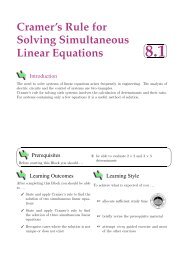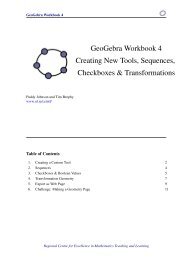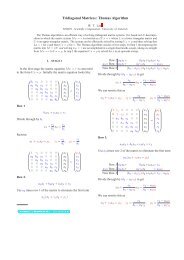Student Notes To Accompany MS4214: STATISTICAL INFERENCE
Student Notes To Accompany MS4214: STATISTICAL INFERENCE
Student Notes To Accompany MS4214: STATISTICAL INFERENCE
You also want an ePaper? Increase the reach of your titles
YUMPU automatically turns print PDFs into web optimized ePapers that Google loves.
When θ ∈ R1 we can define the score function as the first derivative of the log-likelihood<br />
S(θ) = ∂<br />
ln L(θ).<br />
∂θ<br />
The maximum likelihood estimate (MLE) ˆ θ of θ is the solution to the score equation<br />
S(θ) = 0.<br />
At the maximum, the second partial derivative of the log-likelihood is negative, so we<br />
define the curvature at ˆ θ as I( ˆ θ) where<br />
I(θ) = − ∂2<br />
ln L(θ).<br />
∂θ2 We can check that a solution ˆ θ of the equation S(θ) = 0 is actually a maximum by<br />
checking that I( ˆ θ) > 0. A large curvature I( ˆ θ) is associated with a tight or strong<br />
peak, intuitively indicating less uncertainty about θ. In likelihood theory I(θ) is a<br />
key quantity called the observed Fisher information, and I( ˆ θ) is the observed Fisher<br />
information evaluated at the MLE ˆ θ. Although I(θ) is a function, I( ˆ θ) is a scalar.<br />
The likelihood function L(θ|x) supplies an order of preference or plausibility among<br />
possible values of θ based on the observed y. It ranks the plausibility of possible values<br />
of θ by how probable they make the observed y. If P (x|θ = θ1) > P (x|θ = θ2) then<br />
the observed x makes θ = θ1 more plausible than θ = θ2, and consequently from<br />
(2.2), L(θ1|x) > L(θ2|x). The likelihood ratio L(θ1|x)/L(θ2|x) = f(θ1|x)/f(θ2|x) is<br />
a measure of the plausibility of θ1 relative to θ2 based on the observed fact y. The<br />
relative likelihood L(θ1|x)/L(θ2|x) = k means that the observed value x will occur k<br />
times more frequently in repeated samples from the population defined by the value θ1<br />
than from the population defined by θ2. Since only ratios of likelihoods are meaningful,<br />
it is convenient to standardize the likelihood with respect to its maximum. Define the<br />
relative likelihood as R(θ|x) = L(θ|x)/L( ˆ θ|x). The relative likelihood varies between 0<br />
and 1. The MLE ˆ θ is most plausible value of θ in that it makes the observed sample<br />
most probable. The relative likelihood measures the plausibility of any particular value<br />
of θ relative to that of ˆ θ.<br />
When the random variables X1, . . . , Xn are mutually independent we can write the<br />
joint density as<br />
fX(x) =<br />
j=1<br />
where x = (x1, . . . , xn) ′ is a realization of the random vector X = (X1, . . . , Xn) ′ , and<br />
the likelihood function becomes<br />
LX(θ|x) =<br />
n�<br />
n�<br />
j=1<br />
fXj (xj)<br />
fXj (xj|θ).<br />
When the densities fXj (xj) are identical, we unambiguously write f(xj).<br />
19






